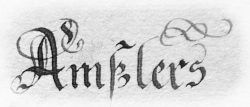The parish records
The story of the Amsler family in Boezen begins with the parish records. With the beginning of the keeping of church records under Bernese rule, one gains insights into the local population. When Bern converted during the Protestant Reformation, the Unteraargau under Bernese rule also converted, although in some cases only under pressure. A few decades after the reformation had spread, the local priests were ordered to register the citizens in their parish. These records, known as “Kirchenbuecher” or church records, are among the earliest and best sources of information for genealogists. Before that time there was hardly any trace of the lives of common people unless they owned substantial property, for example a flour mill, held an office or committed a crime.
Initially the church records were limited to recording the dates when children were baptized, the names of the parents and often the names of the witnesses. Later marriage and death records were added and as time went by, they became more detailed. Registers might contain information about occupations and trades or if a spouse was from out of town. All this data allows the establishment of family trees based on paper trails. Many of these records still preserved today were started in the second half of the 16th century, a few decades after the reformation was introduced. Most of the information regarding the Amsler families is based on these church records, although occasionally other sources provide insight in the lives of our ancestors.
A Swiss specialty: The citizen and hometown principle
A special feature in Switzerland is the principle of the home town. Every Swiss citizen has a home town to which he or she belongs and where family records are kept. The acquisition of Swiss citizenship also begins with naturalization in the community of residence, which becomes the home town after approval by the cantonal and federal authorities. In the past, citizenship in the home municipality was associated with certain rights and duties. These have largely disappeared today. But the civil registers have remained. In them, the people with rights of citizenship are registered, similar to the former church registers. On the basis of these citizen registers, every Swiss citizen is also issued a certificate of origin with which he or she can register as a Swiss citizen in the registration office of the place of residence.
Since the beginning of record keeping, the family records for most Swiss people can be found in the church books and later the citizen registers of the same hometown. This is where we find the data of the Amsler families with the home municipalities of Densbueren, Schinznach and Boezen. Other Swiss families may have moved away over the centuries and have exchanged their original home town with their new place of residence. Or they have acquired a new hometown through marriage. Still others have kept their old hometown despite having moved away. And still other family names have simply disappeared.
After the 19th century, the surname Amsler is found in dozens of different municipalities, however always with the reference to the original place of origin.
Difficulties in creating a family tree
Regarding Boezen, the author of this post has visited the village archive many times and recently photographed every page of the older books in order to transcribe them at home. With this data and paper trails one can establish a family tree for almost any citizen with the hometown being Boezen. After around 1750, family registers were kept which make it easier to track individual families, but before that time it is considerably more difficult. The local priest simply kept sequential records of births, marriages and deaths. In the birth records you would find the names of the parents and witnesses. In the death registers you might get an indication of age of the deceased, but that is spotty. Using this information one can piece together a family tree.
In these records we encounter much diversity, from clean and meticulous handwritings to almost unreadable, all depending on the individual in charge at the time. So it takes quite a bit of expertise to decipher the scripture of various authors’ records over the centuries. Also, often multiple families with the same family name would exist at any given time combined with a somewhat limited selection of first names. This makes it extremely difficult to be certain of generation and family linkages. I often find diverging information and mismatches in what appears to be well researched family trees.
Here are the first three generations of the Amsler family in Boezen:

The highlighted names point to the progenitors of the Amsler families in Bözen and Effingen. The earliest records indicate that the Amslers first settled in Effingen. It was not until at least 1653 when Johannes moved to Boezen. His stepbrother Jacob remained in Effingen.
If we only consider the “Bözen Line,” we can display the first five generations of the Amsler family in Boezen:

The highlighted names in this image point to other blog posts, where additional information is shared:
- Kaspar Amsler, born 1595, served as bailiff in Effingen from 1643 until 1668
- The story on how Hans Amsler, born 1652, came by his nickname “Beldi Hans”
- Anna Heuberger, her three admirers and marriage in 1679




